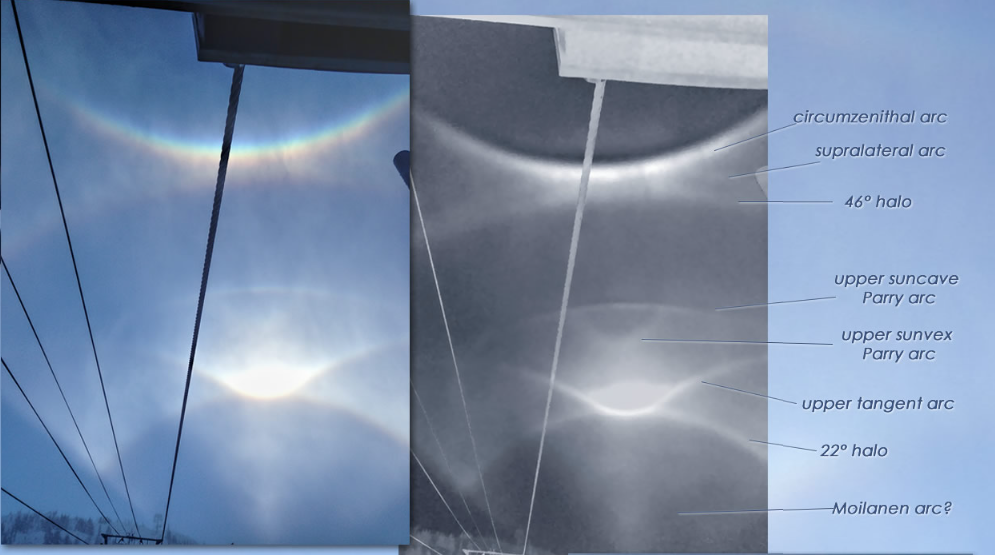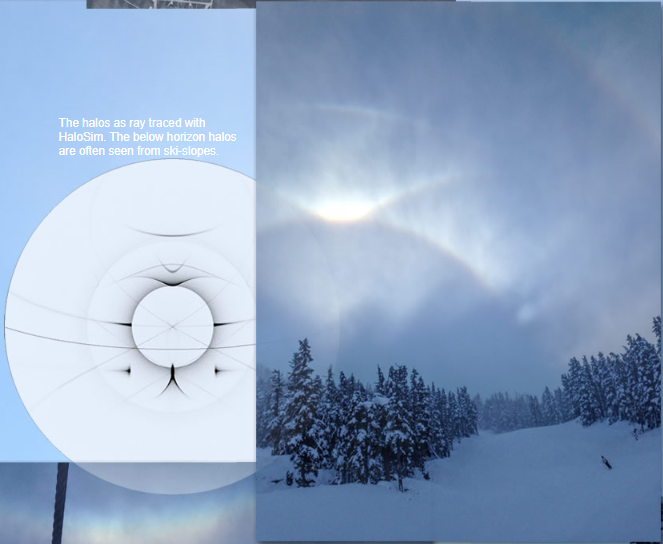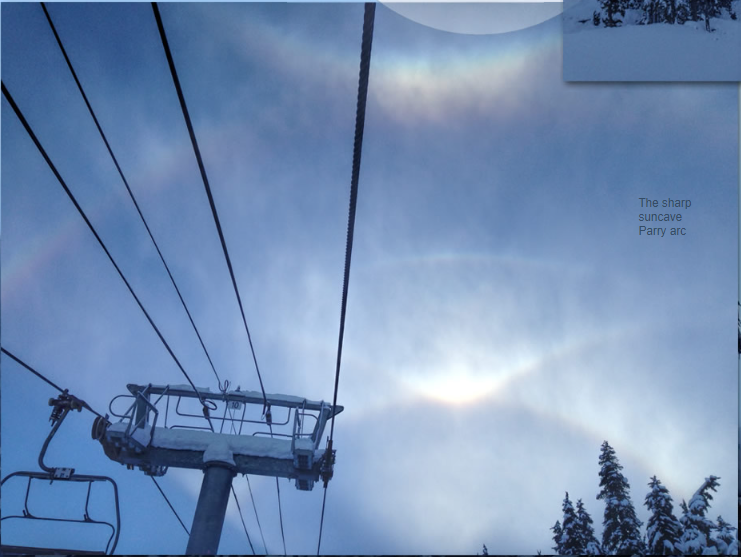Halos at Whistler, Canada - OPOD
Halos at Whistler, Canada: A Mesmerizing Display of Atmospheric Optics
Whistler, British Columbia, Canada, is renowned for its breathtaking natural beauty and world-class ski slopes. However, on Christmas Day in 2014, something truly extraordinary occurred in the skies above Blackcomb Mountain. Fiona Gidden, armed only with her trusty iPhone, captured a stunning display of halos, showcasing the enchanting phenomenon of atmospheric optics.
Unveiling the Enigmatic Diamond Dust Display
Within this captivating spectacle, several unusual features of the diamond dust display emerged, leaving onlookers in awe:
-
The 46° Halo: Nestled near the circumzenithal arc, a vibrant colored halo known as the 46° halo made its presence felt. While the supralateral arc typically intersects with the circumzenithal arc, the 46° halo approaches it only when the sun is positioned at altitudes between 15 and 27°. Interestingly, during this particular event, the sun was a mere 12° high.
-
Two Parry Arcs: The altitude of the sun played a pivotal role in shaping this mesmerizing display. When the sun is near the horizon, the sunvex Parry arc aligns closely with the upper tangent arc, while the suncave Parry arc appears faintly. As the sun ascends, the sunvex arc gradually separates from the upper tangent arc. At approximately 14°, it tangentially aligns with the dominant suncave Parry arc. A mere 2° higher, and the sunvex Parry arc diminishes into a faint smudge. This fascinating interplay between the two Parry arcs can be further explored using HaloSim.
-
The Mysterious Moilanen Arc: One wonders if the elusive Moilanen arc was present during this spectacle. Typically observed in ski-slope displays, where crystals form downwind of snow blowers, the formation of the Moilanen arc remains uncertain. Its presence or absence in this particular event adds an intriguing layer of curiosity to the already bewitching display.
A Visual Feast: Immersing in the Halos of Whistler
As we gaze upon the captivating images captured by Fiona Gidden, our eyes are drawn to the intricate details that unfold within this extraordinary atmospheric optics display. The vibrant colors and ethereal nature of the halos transport us to a realm where science and art converge.
The halo phenomenon is a result of the interaction between sunlight and ice crystals suspended in the atmosphere. These crystals act as tiny prisms, refracting and reflecting light in various ways, leading to the creation of the awe-inspiring halos that grace our skies.
The Science Behind Halos: Unveiling the Secrets of Nature's Light Show
To truly appreciate the splendor of halos, it is essential to understand the scientific principles that underpin their formation. Here's a glimpse into the intricate mechanisms at play:
-
Refraction: As sunlight passes through ice crystals, it undergoes refraction, causing the light to change direction. This bending of light rays is responsible for the creation of halos.
-
Reflection: When light encounters the surface of an ice crystal, it can be reflected back towards the observer. This reflection contributes to the formation of halos and their distinctive patterns.
-
Scattering: As light interacts with ice crystals, it scatters in different directions. This scattering process gives rise to the vibrant colors that adorn halos, adding to their allure.
-
Crystal Orientation: The orientation of ice crystals also influences the appearance of halos. Different crystal shapes and orientations can produce unique halo phenomena, resulting in a diverse range of optical displays.
Exploring Atmospheric Optics: A Journey into Nature's Artistry
The enchanting halos witnessed at Whistler, Canada, serve as a reminder of the beauty and complexity of atmospheric optics. As we delve deeper into this captivating field, we uncover a world of wonders waiting to be explored:
-
Rainbows: Beyond halos, rainbows are another mesmerizing optical phenomenon. Created by the refraction, reflection, and dispersion of sunlight through water droplets in the atmosphere, rainbows paint the sky with a vibrant spectrum of colors.
-
Sun Dogs and Sundogs: Sun dogs, also known as parhelia, are bright spots that appear on either side of the sun. These captivating atmospheric phenomena arise due to the refraction of sunlight by ice crystals in the air.
-
Circumhorizontal Arcs: Often referred to as "fire rainbows," circumhorizontal arcs are rare optical displays that form when sunlight passes through hexagonal ice crystals in cirrus clouds. These arcs appear parallel to the horizon and create a breathtaking spectacle.
Embracing the Mysteries of the Skies
As we stand witness to the astonishing halos at Whistler, Canada, we are reminded of the immense beauty and wonder that surrounds us. Atmospheric optics offers a glimpse into the intricate workings of nature's artistic palette, unveiling a myriad of optical phenomena that continue to captivate and inspire.
Let us embrace these mysteries, immersing ourselves in the enigmatic dance of light and ice crystals that grace our skies. For it is in these moments of perplexity and burstiness that we truly appreciate the awe-inspiring beauty of our world.

Halos at Whistler, BC, Canada
Fiona Gidden captured these halos on Blackcomb Mountain Christmas Day, �14 using her iPhone .
All images ©Fiona Gidden, shown with permission

Unusual features of this diamond dust display:
46° halo – The coloured halo near the circumzenithal arc is a 46° halo. The more common supralateral arc always touches the CZA. The 46° halo only approaches it at sun altitudes between 15 and 27°. Here the sun is only 12° high.
Two Parry arcs – The sun altitude is again influential. When the sun is close to the horizon the sunvex Parry is very close to the upper tangent arc and the suncave parry is very weak indeed. As the sun climbs the sunvex arc separates from the UTA. At 14° it is roughly tangent to the now dominant suncave Parry. 2° higher and the sunvex Parry is just a faint smudge. Try it in HaloSim. Note the sharpness of the suncave Parry.
Moilanen arc – Is it there? Possibly. It is often seen in ski-slope displays when the crystals nucleate downwind of snow blowers. We are uncertain about how the Moilanen forms.


Note: this article has been automatically converted from the old site and may not appear as intended. You can find the original article here.
Reference Atmospheric Optics
If you use any of the definitions, information, or data presented on Atmospheric Optics, please copy the link or reference below to properly credit us as the reference source. Thank you!
-
<a href="https://atoptics.co.uk/blog/halos-at-whistler-canada-opod/">Halos at Whistler, Canada - OPOD</a>
-
"Halos at Whistler, Canada - OPOD". Atmospheric Optics. Accessed on November 15, 2024. https://atoptics.co.uk/blog/halos-at-whistler-canada-opod/.
-
"Halos at Whistler, Canada - OPOD". Atmospheric Optics, https://atoptics.co.uk/blog/halos-at-whistler-canada-opod/. Accessed 15 November, 2024
-
Halos at Whistler, Canada - OPOD. Atmospheric Optics. Retrieved from https://atoptics.co.uk/blog/halos-at-whistler-canada-opod/.